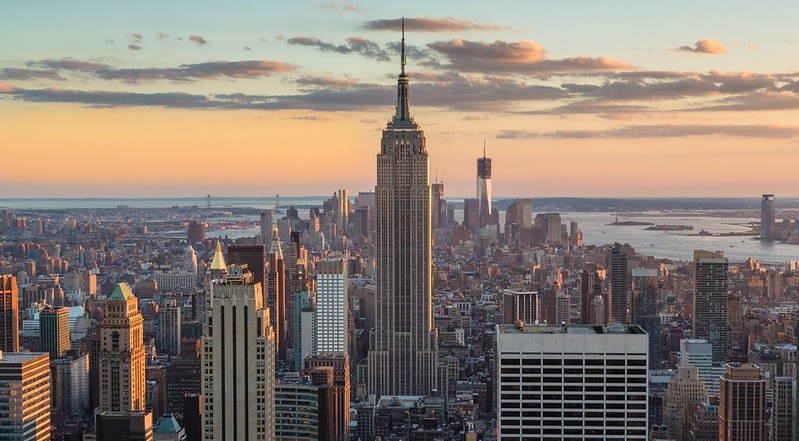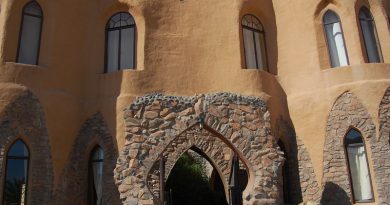Six Fantastic Buildings that made New York
- Grand Central Terminal The Grand Central Terminal was designed to inspire the traveller and to impress on them that they were about to enter, the self-asserted, most powerful city on the planet.
The 2,500 stars of the Sky Ceiling that twinkle 125 feet above the Main Concourse were supposed to depict a view of the constellations above Manhattan on an autumn night, but were painted backwards. The mistake was never corrected, and the ceiling still gives visitors a “God’s eye view” of New York’s nighttime sky.
Grand Central was originally built for $80 million, which translates to about $1.6 billion in today’s money.
Grand Central was built in 1913 in the Beaux Arts style of Paris. It combined the structure and balance of Greek and Roman classicism with some of the flair of the Renaissance. Almost demolished in the 1950’s the building was preserved as a landmark (after a supreme court ruling). After a decade of restoration and almost 200 million dollars, Grand Central has been restored to its former glory.
- Brooklyn Bridge :The Brooklyn Bridge. The Bridge was meant not simply to join Manhattan to Brooklyn but also to create a lasting monument that would continue to inspire awe.
At the time of its completion in 1883, The Brooklyn Bridge was the longest suspension bridge in the world. It was designed by the engineer John Roebling who died on site. His son succeeded him but was paralyzed by lockjaw. His wife, Emily Roebling became the surrogate Chief Engineer for the bridge between 1872 and it’s opening in 1883. To keep the bridge construction in the Roebling name, Emily Roebling continued the work of her husband. She learned higher math and engineering through “on-the-job” training.
- The Flat Iron Building: Manhattan is unique in its place as a world city and with limited area on the island to grow there was only one place to build: up.
The Flat Iron building’s 22 floors may not seem much by today standards, but in 1902 This was enormous. Its unique shape was the only solution to the rectangular plot of land created by Broadway crossing 5th Avenue.
In fact the shape of the building used to cause strange winds at ground level. So much so that a policeman had to be posted there to stop men congregating and looking at women’s skirts as the wind forced them up..
- Woolworth Building
Just around the corner from Wall Street, now dwarfed by newer buildings, is a monument to the king of nickels and dime stores, the Woolworth building.
Completed by Cass Gilbert in 1913 in gothic style, his “Cathedral of Commerce” was the first building in the world to reach 60 floors and stood as the world’s tallest for 17 years. It was adorned with gothic style gargoyles and ornaments. The building cost 13.5 million dollars, a staggering amount in 1913, and was paid in cash. Like many great buildings of this era it was an obsession by one man to leave his mark on this city.
- Chrysler Building
Frank Woolworth was the first and many more followed. In 1929 there was a race between two parties to build the next “world’s tallest.” Downtown there was 40 Wall street, for the bank of Manhattan, a building now almost lost in a sea of towers and in Midtown, it was the Chrysler building, Walter Chryslers’ stunning Art deco masterpiece.
Walter Chrysler found out that 40 Wall Street was going to be taller than his building so he had his architect add height with his new two-piece spire.”
When 40 Wall Street was completed it was the world’s tallest. But their joy was short lived as the builders at the Chrysler literally hoisted up a central spire before their very eyes beating the bank of Manhattan by just a few feet.
The Chrysler building is the prima donna of all skyscrapers and the bell of the Manhattan skyline. It’s extravagance is a reflections of the excesses of the roaring 20’s at a time when New York was in love with it’s own image of decadence.
It’s interior summed up Art Deco- the geometry of Vienna, acute angles from German expressionism, collaged effects of cubism.- As well as lighting and drama from theatre and film.
It’s true external beauty comes from the spire. A series of sunbursts punctuated by triangular windows, it was designed to emulate the chrome wheels and radiator caps of 1920 Chrysler cars. Like the Woolworth building it was a tribute to the success of the man that built it.
- Empire State Building
After the 1929 crash architecture sobered up and buildings became more about practicality than expression. However, erected in the midst of the great depression one building still dominates the midtown skyline.
John Jacob Raskob’s infamous structure – built in the wrong place at the wrong time, was the Empire state building.
It started with a pencil, which Raskob placed on one end, and said to William Lamb, his principal architect,: How high can you build it so that it won’t fall down? His answer came back- pretty damn high.
Built during the great depression and 20 blocks from the Midtown business district, it was doomed to be a financial failure. But the building itself was a masterpiece, 3,400 workers took just 13 months to complete it, New Yorkers watched in awe as it rose so rapidly from the ground.
The Empire State Building is 12285 feet high. It takes ten minutes to get up and 10 seconds to jump off and hit the bottom.
William Lamb left New York by boat for Europe the day the building opened and telegrammed back, “One day out and I can still see the building”.
A proud symbol of New York resilience, it didn’t make a profit for over a quarter of a century but stood as the world tallest for 40 years.
Only in 1972 were two buildings in the world built higher and these have become irrevocably linked to American history and even the history of the world.




